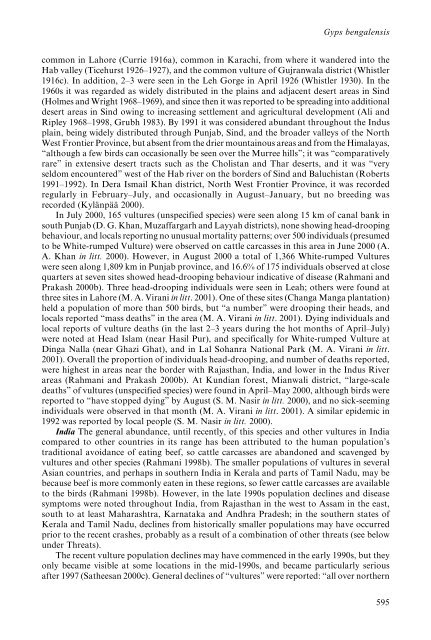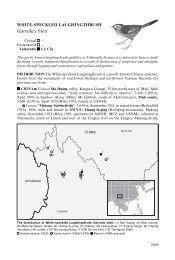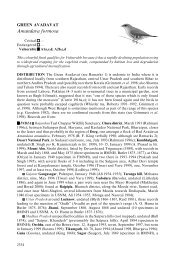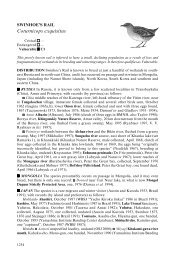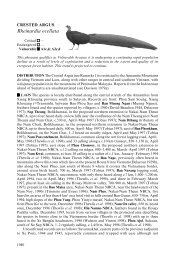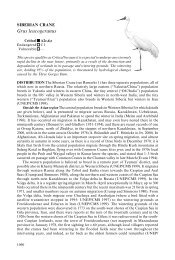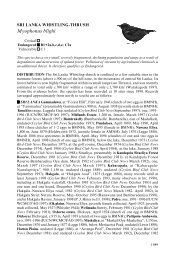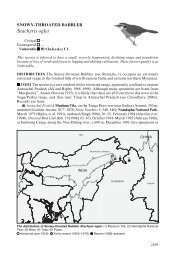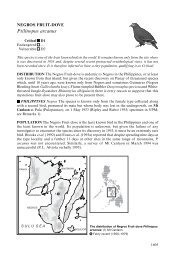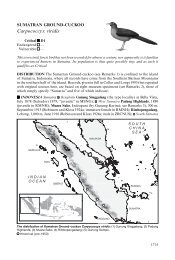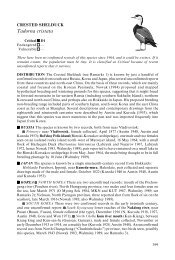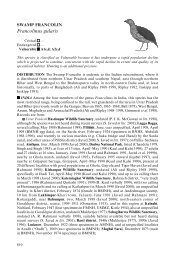Gyps bengalensis - BirdBase
Gyps bengalensis - BirdBase
Gyps bengalensis - BirdBase
Create successful ePaper yourself
Turn your PDF publications into a flip-book with our unique Google optimized e-Paper software.
<strong>Gyps</strong> <strong>bengalensis</strong><br />
common in Lahore (Currie 1916a), common in Karachi, from where it wandered into the<br />
Hab valley (Ticehurst 1926–1927), and the common vulture of Gujranwala district (Whistler<br />
1916c). In addition, 2–3 were seen in the Leh Gorge in April 1926 (Whistler 1930). In the<br />
1960s it was regarded as widely distributed in the plains and adjacent desert areas in Sind<br />
(Holmes and Wright 1968–1969), and since then it was reported to be spreading into additional<br />
desert areas in Sind owing to increasing settlement and agricultural development (Ali and<br />
Ripley 1968–1998, Grubh 1983). By 1991 it was considered abundant throughout the Indus<br />
plain, being widely distributed through Punjab, Sind, and the broader valleys of the North<br />
West Frontier Province, but absent from the drier mountainous areas and from the Himalayas,<br />
“although a few birds can occasionally be seen over the Murree hills”; it was “comparatively<br />
rare” in extensive desert tracts such as the Cholistan and Thar deserts, and it was “very<br />
seldom encountered” west of the Hab river on the borders of Sind and Baluchistan (Roberts<br />
1991–1992). In Dera Ismail Khan district, North West Frontier Province, it was recorded<br />
regularly in February–July, and occasionally in August–January, but no breeding was<br />
recorded (Kylänpää 2000).<br />
In July 2000, 165 vultures (unspecified species) were seen along 15 km of canal bank in<br />
south Punjab (D. G. Khan, Muzaffargarh and Layyah districts), none showing head-drooping<br />
behaviour, and locals reporting no unusual mortality patterns; over 500 individuals (presumed<br />
to be White-rumped Vulture) were observed on cattle carcasses in this area in June 2000 (A.<br />
A. Khan in litt. 2000). However, in August 2000 a total of 1,366 White-rumped Vultures<br />
were seen along 1,809 km in Punjab province, and 16.6% of 175 individuals observed at close<br />
quarters at seven sites showed head-drooping behaviour indicative of disease (Rahmani and<br />
Prakash 2000b). Three head-drooping individuals were seen in Leah; others were found at<br />
three sites in Lahore (M. A. Virani in litt. 2001). One of these sites (Changa Manga plantation)<br />
held a population of more than 500 birds, but “a number” were drooping their heads, and<br />
locals reported “mass deaths” in the area (M. A. Virani in litt. 2001). Dying individuals and<br />
local reports of vulture deaths (in the last 2–3 years during the hot months of April–July)<br />
were noted at Head Islam (near Hasil Pur), and specifically for White-rumped Vulture at<br />
Dinga Nalla (near Ghazi Ghat), and in Lal Sohanra National Park (M. A. Virani in litt.<br />
2001). Overall the proportion of individuals head-drooping, and number of deaths reported,<br />
were highest in areas near the border with Rajasthan, India, and lower in the Indus River<br />
areas (Rahmani and Prakash 2000b). At Kundian forest, Mianwali district, “large-scale<br />
deaths” of vultures (unspecified species) were found in April–May 2000, although birds were<br />
reported to “have stopped dying” by August (S. M. Nasir in litt. 2000), and no sick-seeming<br />
individuals were observed in that month (M. A. Virani in litt. 2001). A similar epidemic in<br />
1992 was reported by local people (S. M. Nasir in litt. 2000).<br />
India The general abundance, until recently, of this species and other vultures in India<br />
compared to other countries in its range has been attributed to the human population’s<br />
traditional avoidance of eating beef, so cattle carcasses are abandoned and scavenged by<br />
vultures and other species (Rahmani 1998b). The smaller populations of vultures in several<br />
Asian countries, and perhaps in southern India in Kerala and parts of Tamil Nadu, may be<br />
because beef is more commonly eaten in these regions, so fewer cattle carcasses are available<br />
to the birds (Rahmani 1998b). However, in the late 1990s population declines and disease<br />
symptoms were noted throughout India, from Rajasthan in the west to Assam in the east,<br />
south to at least Maharashtra, Karnataka and Andhra Pradesh; in the southern states of<br />
Kerala and Tamil Nadu, declines from historically smaller populations may have occurred<br />
prior to the recent crashes, probably as a result of a combination of other threats (see below<br />
under Threats).<br />
The recent vulture population declines may have commenced in the early 1990s, but they<br />
only became visible at some locations in the mid-1990s, and became particularly serious<br />
after 1997 (Satheesan 2000c). General declines of “vultures” were reported: “all over northern<br />
595


